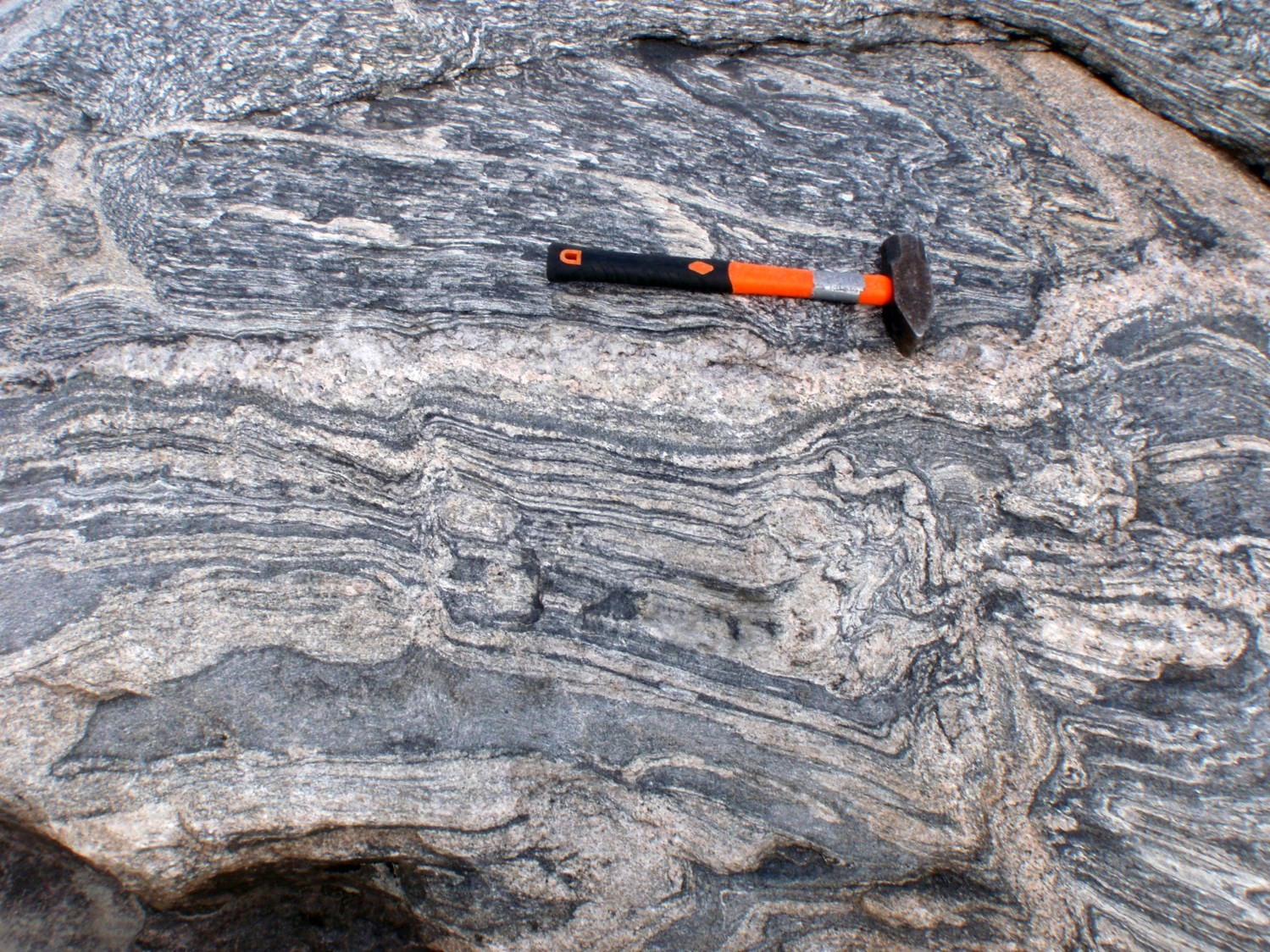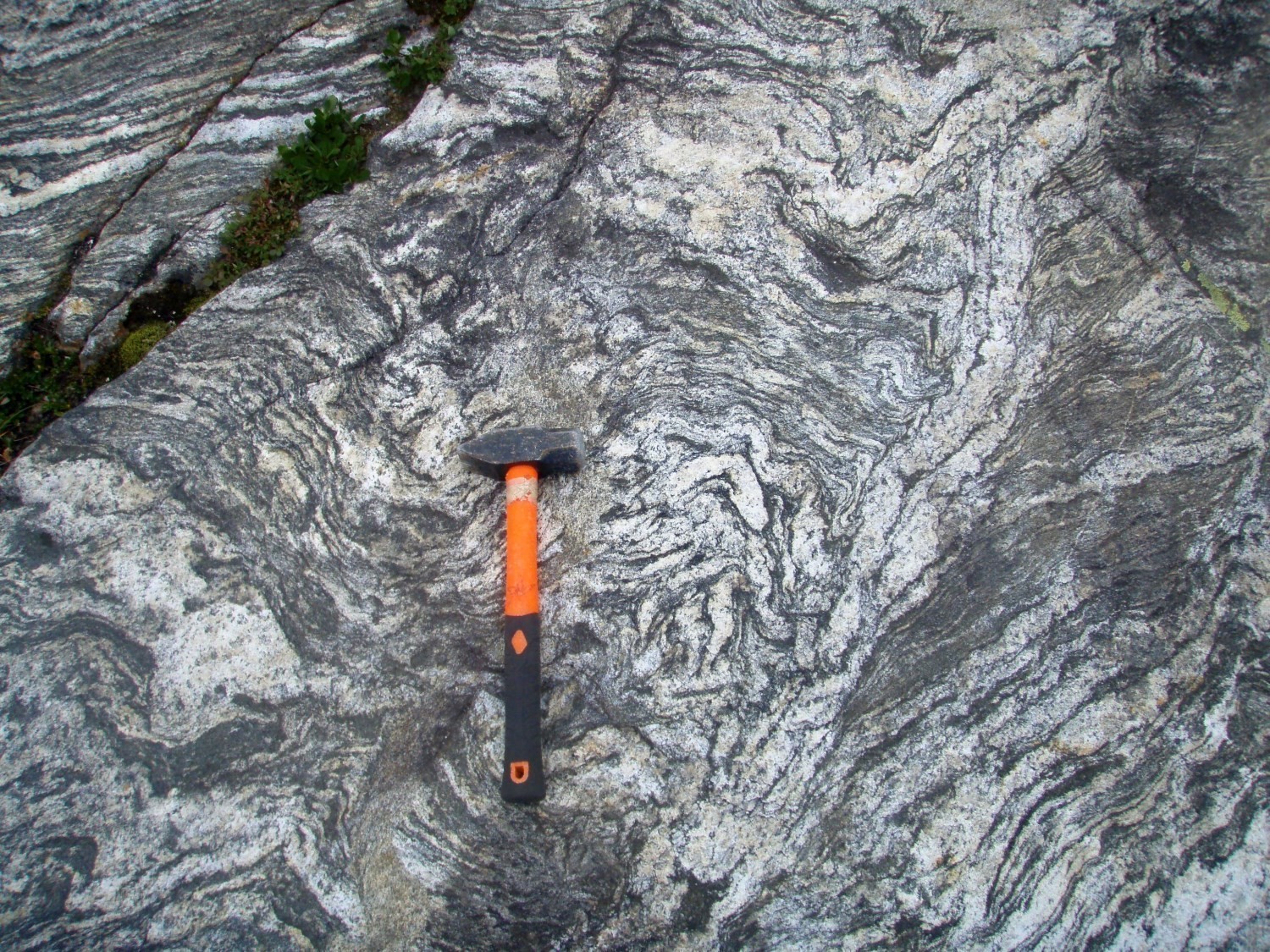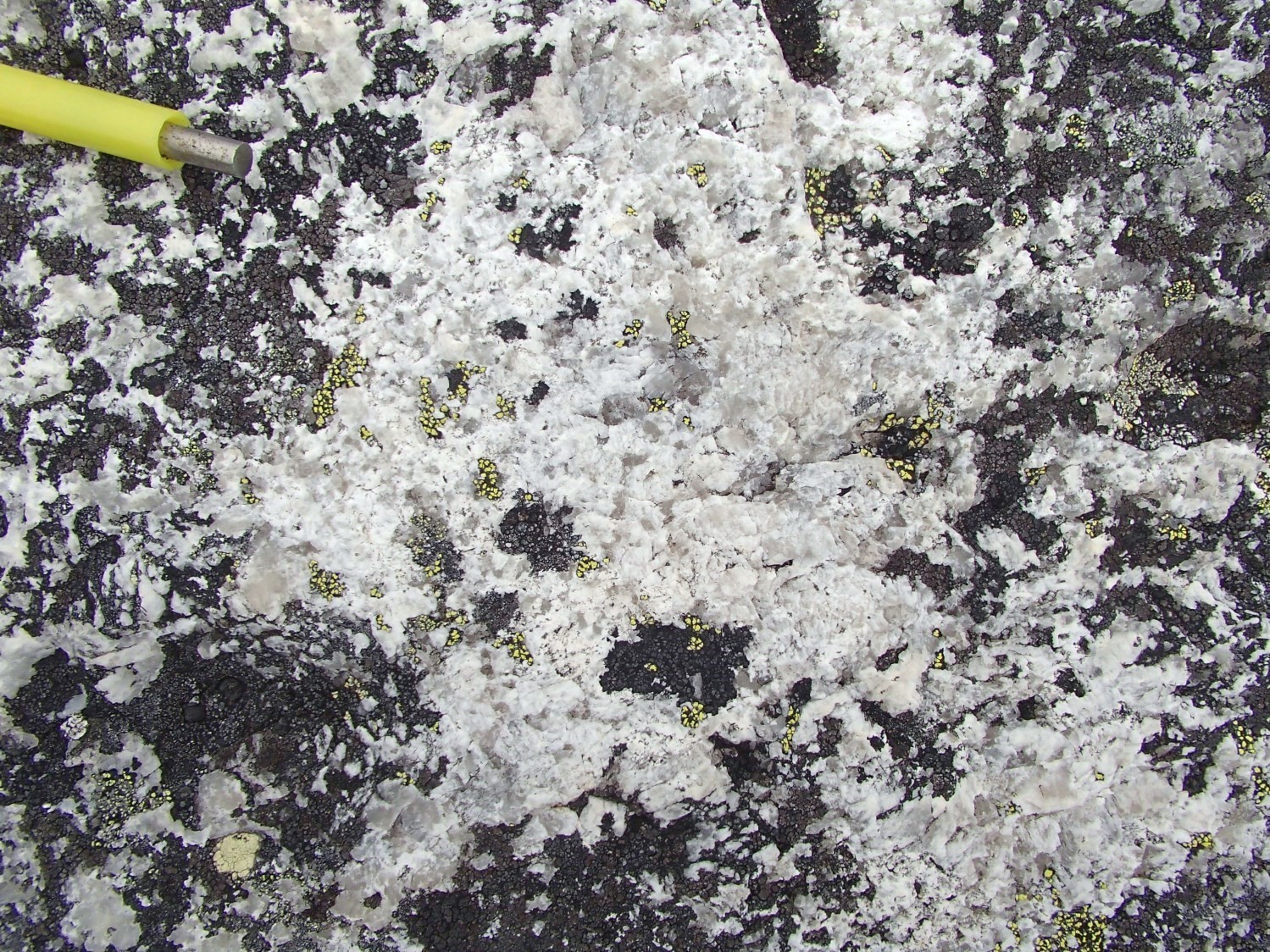
Last modified: 7 October 2022
DISCLAIMER: This English version is translated from the original French. In case of any discrepancy, the French version shall prevail.
| Author(s): | Mathieu et al., 2018 |
| Age: | Paleoproterozoic |
| Stratotype: | None |
| Type area: | Koroc River area (NTS sheet 24I) |
| Geological province: | Churchill Province |
| Geological subdivision: | Falcoz Lithotectonic Domain |
| Lithology: | Migmatitic rocks and ultrametamorphic granite |
| Category: | Lithodemic |
| Rank: | Complex |
| Status: | Formal |
| Use: | Active |
None
Background
The Fougeraye Complex was introduced by Mathieu et al. (2018) in the Koroc River area to group migmatitic rocks and ultrametamorphic granites possibly derived from the melting of orthogneisses of the Kangiqsualujjuaq Complex (Akan). In the same area, Verpaelst et al. (2000) did not separate migmatitic rocks from tonalitic gneisses, grouping them together within the Kangiqsualujjuaq Complex. The ultrametamorphic granites were grouped in the Baudan Complex (now Baudan Suite). In the entire southeastern Churchill Province (SEPC), Simard et al. (2013), Lafrance et al. (2014, 2015 and 2016), and Charette et al. (2016) preferred to distinguish the gneisses and the resulting migmatites by assigning them to the Ungava and Qurlutuq complexes, respectively. Following a synthesis of the SECP (Lafrance et al., 2018), different lithotectonic domains have been identified and it appears that the gneisses observed within these domains are distinct from each other.
In the Falcoz Lithotectonic Domain, located east of the Moonbase (ZCmob) and Rivière George (ZCrge) anastomosed shear zones, migmatitic rocks and ultrametamorphic granites interpreted as derived from the melting of orthogneisses are currently assigned to the Fougeraye Complex (Mathieu et al., 2018; Lafrance and Vanier, 2022). This complex thus includes part of the outcrops formerly assigned to the Kangiqsualujjuaq and Baudan complexes by Verpaelst et al. (2000); however, it does not include the ultrametamorphic granites interpreted to be derived from the melting of the Lake Harbour Suite paragneisses, which are grouped into the Abrat Suite. The table below summarizes the correspondences between the current and previous units.
| Revised Units and Subunits | Previous Units and Subunits | Reference(s) |
|
pPfog1 |
ApPkan1 (partly) |
Verpaelst et al., 2000 |
|
ApPqur (east of ZCrge and ZCmob) |
Simard et al., 2013; Lafrance et al., 2015 and 2016 |
|
|
pPfog2 |
ApPban2 (partly) |
Verpaelst et al., 2000 |
|
pPavn1 (east of ZCrge and ZCmob) |
Simard et al., 2013; Lafrance et al., 2015 and 2016 |
|
|
pPfog2a |
pPavn1a (east of ZCrge and ZCmob) |
Lafrance et al., 2015 and 2016 |
Description
The Fougeraye Complex has been divided into two informal units, a banded migmatitic rock unit (pPfog1) and an ultrametamorphic tonalite and granite unit (pPfog2).
Fougeraye Complex 1 (pPfog1): Migmatitic Rocks
Migmatites of unit pPfog1 comprise stromatic metatexite and raft-textured diatexite. In the metatexite, the leucosome forms leucocratic and undulating centimetric bands. This leucosome is mostly tonalitic but can be locally granitic or granodioritic. The diatexite contains many decimeter to decameter-wide gneiss rafts of variable composition, similar to those of the Kangiqsualujjuaq Complex. The variation in the leucosome composition appears to be related to the composition of the gneiss affected by partial melting. The neosome, regardless of its composition, is whitish to light grey and contains between 10 and 30% biotite ± hornblende schlieren. The proportion of quartzofeldspathic minerals also varies significantly. Quartz is in the form of large anhedral zones with undulatory extinction or subgrains. It makes up 20-30% of the rock, while potassium feldspar makes up 0-50% of the rock (usually <6%). Quartz also forms small, rounded grains. Microscopically, the rock has a variable grain size with large grains of igneous origin alternating with finer-grained recrystallized clusters or bands. The schlieren also include a significant percentage of accessory minerals consisting, in order of importance, of epidote (<2%), apatite (<1%), sphene, zircon (as inclusions in biotite), opaque minerals, and muscovite. Allanite cores are widely observed within the epidote (pistachite and zoisite). Altered minerals such as chlorite, sericite and carbonates are locally present.
Fougeraye Complex 2 (pPfog2): Tonalite and anatectic granite
Unit pPfog2 consists of massive to foliated tonalite and white granite. The foliation is mainly due to the alignment of biotite ± hornblende schlieren (~5% ferromagnesian minerals). This unit contains up to 15% centimetric to decimetric enclaves of gneiss of the Kangiqsualujjuaq Complex, migmatites of unit pPfog1, and gabbro and gabbronorite of the Nuvulialuk Suite (pPnuv). Most of these enclaves show deformation prior to the emplacement of the intrusive rock. Unit pPfog2 also contains irregular, decimetric to decametric clusters and pockets of whitish pegmatite in diffuse contact. Grain size is heterogeneous and clusters of fine to coarse grains are observed. In thin section, the distribution of the minerals is commonly uneven, forming large monomineralic zones. Reactional microtextures at grain contacts, as well as antiperthitic and myrmekitic textures are abundantly observed. Quartz (30-35%) is anhedral and has a strong undulatory extinction. Minor accessory minerals are muscovite (1-3%), opaque minerals, sphene, epidote and zircon.
Fougeraye Complex 2a (pPfog2a): Heterogeneous tonalite and anatectic granite with biotite schlieren
Subunit pPfog2a refers to areas where whitish intrusions of the Fougeraye Complex are more heterogeneous due to the presence of many partially assimilated enclaves and 10 to 30% biotite ± hornblende schlieren in the rock. In these heterogeneous areas, samples are similar to migmatitic rocks of the pPfog1 unit; however, there is no real banding in outcrop or on a fresh surface. Accessory minerals include allanite, chlorite, apatite, muscovite, zircon and tourmaline
Thickness and distribution
The Fougeraye Complex covers an area of ~3251 km2 within the Falcoz Lithotectonic Domain. The pPfog1 unit (~3024 km2) is the largest and forms strips several kilometres wide followed over several kilometres. The pPfog2 unit (~63 km2) and the pPfog2a subunit (~164 km2) form smaller intrusions.
Dating
The Paleoproterozoic age ~1835 Ma is interpreted as the end of migmatite crystallization. This age is synchronous with the Torngat Orogeny (1885 Ma to 1810 Ma; Charette, 2016; Charette et al., 2021). Archean ages of the protolith tend to confirm that the Fougeraye Complex derives from melting of the gneissic basement.
| Unit | Sample Number | Isotopic System | Mineral | Crystallization Age (Ma) | (+) | (-) | Inherited Age (Ma) | (+) | (-) | Reference(s) |
| pPfog1 | 2017-MV-1227A | U-Pb | Zircon | 1834.7 | 5.5 | 5.5 | 2780 | 11 | 11 | David, 2020 |
| 2828 | 15 | 15 |
Stratigraphic Relationship(s)
Migmatitic rocks of the Fougeraye Complex are spatially associated with gneisses of the Kangiqsualujjuaq Complex, with which they are in gradual and poorly defined contact. Banding of migmatitic rocks of unit pPfog1 is irregular, undulating, discontinuous and commonly chaotic, distinguishing it from the straighter and more regular banding of gneiss. The intrusive rocks of unit pPfog2 are similar to the leucosome of the pPfog1 migmatites. The rocks of the Fougeraye Complex contain orthogneiss enclaves of the Kangiqsualujjuaq Complex. The change in composition, from tonalite to granite, can be linked to the composition of the gneiss of the Kangiqsualujjuaq Complex. The observations presented above support that the rocks of the Fougeraye Complex result from the partial melting of these gneisses. Thus, the tonalites and granites of the pPfog2 unit could correspond to an evolved, late phase (ultrametamorphic granite) related to the partial melting phenomenon that gave rise to this complex (Mathieu et al., 2018).
Paleontology
Does not apply.
References
Publications available through SIGÉOM Examine
CHARETTE, B., LAFRANCE, I., MATHIEU, G., 2016. Géologie de la région du lac Jeannin, Québec, Canada. MERN; BG 2015-01, 1 plan.
DAVID, J., 2020. Datations U-Pb dans les provinces du Supérieur et de Churchill effectuées au GEOTOP en 2017-2018. MERN, GEOTOP; MB 2020-05, 29 pages.
LAFRANCE, I., SIMARD, M., BANDYAYERA, D., 2014. GEOLOGIE DE LA REGION DU LAC SAFFRAY (SNRC 24F, 24G). MRN; RG 2014-02, 51 pages, 1 plan.
LAFRANCE, I., BANDYAYERA, D., BILODEAU, C., 2015. GEOLOGIE DE LA REGION DU LAC HENRIETTA (SNRC 24H). MERN; RG 2015-01, 62 pages, 1 plan.
LAFRANCE, I., BANDYAYERA, D., CHARETTE, B., BILODEAU, C., DAVID, J., 2016. GEOLOGIE DE LA REGION DU LAC BRISSON (SNRC 24A). MERN; RG 2015-05, 64 pages, 1 plan.
LAFRANCE, I., CHARETTE, B., VANIER, M.-A., 2018. Sud-est de la Province de Churchill, Nunavik, Québec, Canada: synthèse de la géologie. MERN; BG 2018-12
LAFRANCE, I., VANIER, M.-A., 2022. Domaine lithotectonique de Falcoz, sud-est de la Province de Churchill, Nunavik, Québec, Canada : synthèse de la géologie. MERN; BG 2022-01, 2 plans.
MATHIEU, G., LAFRANCE, I., VANIER, M.-A., 2018. Géologie de la région de pointe Le Droit, Province de Nain et sud-est de la Province de Churchill, Nunavik, Québec, Canada. MERN; BG 2018-07, 4 plans.
SIMARD, M., LAFRANCE, I., HAMMOUCHE, H., LEGOUIX, C., 2013. GEOLOGIE DE LA REGION DE KUUJJUAQ ET DE LA BAIE D’UNGAVA (SNRC 24J, 24K). MRN; RG 2013-04, 62 pages, 1 plan.
VERPAELST, P., BRISEBOIS, D., PERREAULT, S., SHARMA, K. N. M., DAVID, J., 2000. Géologie de la région de la rivière Koroc et d’une partie de la région de Hébron, 24I et 14L. MRN; RG 99-08, 62 pages, 10 plans.
Other publications
CHARETTE, B., 2016. Long-lived Anatexis in the Exhumed Middle Crust from the Torngat Orogen and Eastern Core Zone: Constraints from Geochronology, Petrochronology, and Phase Equilibria Modeling. Thèse de maîtrise, University of Waterloo, 389 pages. uwspace.uwaterloo.ca/handle/10012/10453
CHARETTE, B., GODET, A., GUILMETTE, C., DAVIS, D.W., VERVOORT, J., KENDALL, B., LAFRANCE, I., BANDYAYERA, D., YAKYMCHUK, C., 2021. Long-lived anatexis in the exhumed middle crust of the Torngat Orogen: Constraints from phase equilibria modeling and garnet, zircon, and monazite geochronology. Lithos, volume 388-389. doi.org/10.1016/j.lithos.2021.106022
Suggested Citation
Ministère de l’Énergie et des Ressources naturelles (MERN). Fougeraye Complex. Quebec Stratigraphic Lexicon. https://gq.mines.gouv.qc.ca/lexique-stratigraphique/province-de-churchill/complexe-de-fougeraye_en [accessed on Day Month Year].
Contributors
|
First publication |
Isabelle Lafrance, P. Geo., M.Sc. isabelle.lafrance@mern.gouv.qc.ca (redaction) Mehdi A. Guemache, P. Geo., Ph.D. (coordination); Julie Vallières, P. Geo., B.Sc. (critical review and editing); Céline Dupuis, P. Geo., Ph.D. (English version); Ricardo Escobar Moran (HTML editing). |
|
Revision(s) |
Isabelle Lafrance, P. Geo., M.Sc. (redaction) Mehdi A. Guemache, P. Geo., Ph.D. (coordination); Marc-Antoine Vanier, Eng., M.Sc. (critical review); Simon Auclair, P. Geo., M.Sc. (editing); Dominique Richard, GIT, Ph.D. (English version); André Tremblay (HTML editing). |




